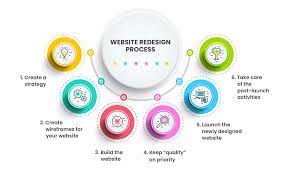In the ever-evolving digital landscape, website redesigns are essential to keep pace with industry trends, technological advancements, and changing user expectations. Explore effective strategies for revamping websites to make a lasting impact, enhance user experience, and achieve business goals.

**1. Define Clear Objectives:
- Strategy: Clearly outline the goals and objectives of the website redesign.
- Impact: Ensures that the redesign aligns with overarching business objectives, whether it’s increasing conversions, improving user engagement, or rebranding.
2. User-Centric Design:
- Strategy: Prioritize user experience in the redesign process.
- Impact: Enhances usability, navigation, and overall satisfaction for visitors, leading to increased engagement and conversions.
3. Responsive and Mobile-Friendly:
- Strategy: Ensure the website is responsive and optimized for mobile devices.
- Impact: Reaches a broader audience and improves search engine rankings, as mobile-friendliness is a key factor in search algorithms.
4. Content Optimization:
- Strategy: Audit and optimize existing content for relevance and SEO.
- Impact: Boosts search engine visibility, improves user engagement, and aligns content with the target audience’s needs.
5. Streamlined Navigation:
- Strategy: Simplify website navigation for a seamless user journey.
- Impact: Reduces bounce rates, increases user retention, and makes it easier for visitors to find the information they seek.
6. Visual Refresh:
- Strategy: Implement a visually appealing and modern design.
- Impact: Enhances brand perception, captures attention, and communicates professionalism and relevance.
7. Performance Optimization:
- Strategy: Optimize website speed and performance.
- Impact: Improves user experience, reduces bounce rates, and positively influences search engine rankings.
8. Integration of Latest Technologies:
- Strategy: Explore and integrate the latest technologies, such as AI, chatbots, or augmented reality.
- Impact: Enhances functionality, provides innovative features, and demonstrates a commitment to staying current.
9. SEO-Focused Redesign:
- Strategy: Conduct thorough keyword research and implement SEO best practices.
- Impact: Improves search engine rankings, increases organic traffic, and ensures visibility for relevant search queries.
10. Conversion Rate Optimization (CRO): – Strategy: Analyze and optimize conversion paths and calls-to-action. – Impact: Boosts conversion rates, turning website visitors into customers or leads more effectively.
11. Social Media Integration: – Strategy: Integrate social media seamlessly with the website. – Impact: Enhances brand visibility, encourages social sharing, and facilitates a cohesive online presence.
12. Accessibility Standards: – Strategy: Ensure compliance with accessibility standards (WCAG). – Impact: Expands the reach to users with disabilities, aligns with ethical design principles, and may positively influence search engine rankings.
13. A/B Testing: – Strategy: Conduct A/B testing for various design elements and features. – Impact: Informs data-driven decisions, identifies optimal design choices, and improves overall website performance.
14. Enhanced Security Measures: – Strategy: Implement robust security measures, including SSL certificates and regular security audits. – Impact: Builds trust with users, protects sensitive data, and safeguards against cyber threats.
15. User Feedback and Testing: – Strategy: Gather user feedback and conduct usability testing. – Impact: Identifies pain points, validates design choices, and ensures the website meets user expectations.
Executing a website redesign with these impactful strategies in mind ensures that businesses not only stay relevant but also thrive in the competitive digital landscape. By focusing on user experience, performance, and aligning design choices with business goals, a website revamp becomes a catalyst for sustained success and positive brand perception.









